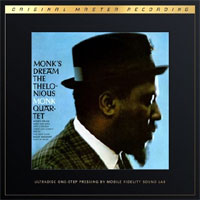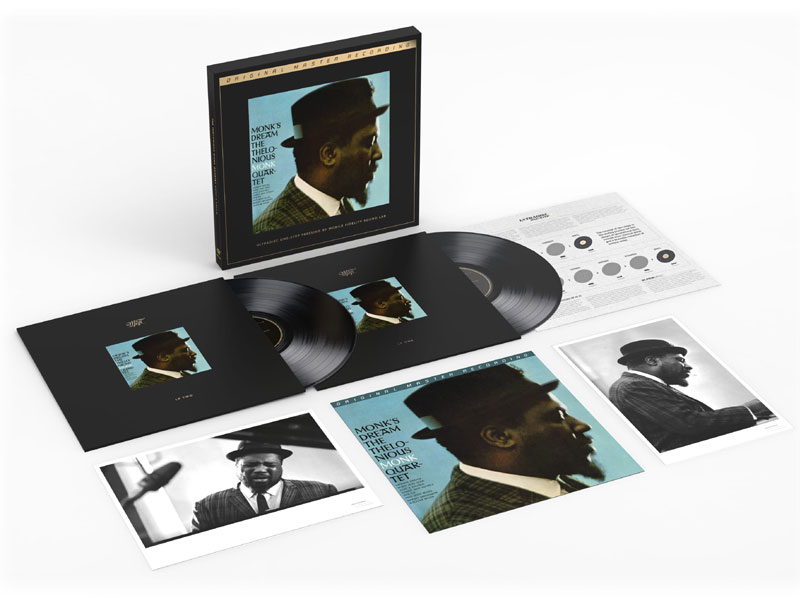Thelonious Monk Quartet • Monk's Dream
 pecialty record labels catering to the audiophile market have been
around for decades, and proprietary processes for mastering and pressing LPs have
flourished during that time -- from half-speed mastering to direct-to-disc pressings, and
steps in between. Heck, even the major labels have tried, in fits and spurts, their hands
at meeting the audiophile demand for the best pressings possible. pecialty record labels catering to the audiophile market have been
around for decades, and proprietary processes for mastering and pressing LPs have
flourished during that time -- from half-speed mastering to direct-to-disc pressings, and
steps in between. Heck, even the major labels have tried, in fits and spurts, their hands
at meeting the audiophile demand for the best pressings possible.
One audiophile label that even non-audiophiles have heard of is Mobile Fidelity, whose LPs have always commanded top dollar on the used market. Mobile Fidelity has devised a new way to create LPs -- Ultradisc One-Step, a mastering process that omits two generational steps in creating the stampers, and thus two points of sonic loss, putting the listener that much closer to the original sound of the master tapes. One-Step is, however, expensive and, by its nature, a limited-run way to press LPs. It limits the number of LPs that can be pressed to a finite number -- only one stamper/convert is created -- hence the higher-than-normal cost of the Ultradisc One-Step releases. Oh, and another thing, Mobile Fidelity’s commitment to the best sound possible is demonstrated in these boxed sets, which are mastered at 45rpm, with all the sonic benefits that this brings to the table, so a single LP suddenly becomes a double-LP set. You also get a sheet explaining the One-Step process, two frameable photos of Monk, and a very nice heavy-stock sheet with the cover on one side and much clearer liner notes on the other. Not essential, but a lovely bonus. For this release, Mobile Fidelity chose Thelonious Monk’s debut on Columbia Records, recorded after he signed with the label in 1962 (and released in 1963). It features Monk on piano, Charlie Rouse on tenor sax, Johnny Ore on bass and Frankie Dunlop on drums -- a group that some consider the best quartet Monk ever recorded with. Listening to them play with, off and around each other certainly lends credence to that statement. I have listened to this album in its CD, SACD and original LP forms, and now I have the Ultradisc One-Step version. I’ve seldom heard a more realistic, lifelike sonic presentation than I do with this new release. The only albums that equal the vivid sonics of this new remastering are direct-to-disc recordings. Yeah, it’s that good. The first thing I noticed was how quiet the surface is, which calls to mind another feature of this extra-special release: SuperVinyl, a carbonless vinyl formula used for these LPs. Its advantages are important to analog playback: lower noise and better groove definition, which lead to more musical detail. Mobile Fidelity has rid this album of much of the hard-left/hard-right soundstage presentation of the original LP, adding a very real sense of acoustic space around each musician that's not apparent with any previous version. Charlie Rouse’s tenor sax seemed to explode from my speakers with a sense of realism I’ve seldom heard before. I got a true sense of his breath blowing through his tenor sax. The sound of Frankie Dunlop’s drum kit is startlingly real, from the snap of his drumsticks on each drumhead, to the placement and clarity of his cymbal strikes. Finally, Johnny Ore’s bass is much more clearly rendered, with added weight and heft. But it’s the second cut, "Tea For Two," which features Monk in solo mode, that will bring you right out of your listening chair. If you’ve ever wondered why the piano is considered a percussion instrument, this track, as presented here, will give you the answer. The sense of Monk playing right in front of me, live and in my room, was eerily real. I truly got to hear both his fingers dancing over and pounding the keyboard, as well as the hammers pounding the strings. Toss in a sense of the instrument completely filling the acoustic space -- that lower noise floor and the quiet surfaces play a huge role here, and I perceive what may be the most realistic piano sound I’ve heard reproduced in my listening room. I also got a real feel for the telepathy these four musicians had with each other. While the material is not new (Monk had basically stopped composing by this point -- though he did create occasional new tunes on subsequent albums), no Monk tune is ever played the same way twice -- Monk was a stickler for every track he and his band played being different from any that had come before. So there is a certain freshness to this album, despite what may appear to be Monk simply regurgitating his earlier compositions. There are no missteps by the players either; each one knows the others well enough to pick up right where he should. They all solo only in proper perspective, and they support each other perfectly.
As to whether the One-Step process and SuperVinyl live up to the hype -- yes, they do, in spades. No, these One-Step LPs don’t come cheap ($125 a shot), but given the work Mobile Fidelity put into creating the ultimate vinyl version of this album, and the sonic results they achieved, if you are as much in love with Thelonious Monk as I am, then the cost becomes a secondary consideration. And given that like most specialty reissues, these Ultradisc One-Step LPs are produced in limited numbers (6000 copies for Monk's Dream), expect the price only to go up if you wait until Monk's Dream is sold out. I’ll probably pull my original LP out every so
often, if only for nostalgia's sake. But when I truly want to use my audio system as a
time machine, resurrect the ghosts of Monk, Rouse, Ore and Dunlop, and invite them into my
home to play just for me, or to demo my system with real music in order to show those who
wonder why we audiophiles are so compulsive about our systems and the media we play on
them, it will be this Ultradisc One-Step version that will find its way to the platter of
my turntable. |

